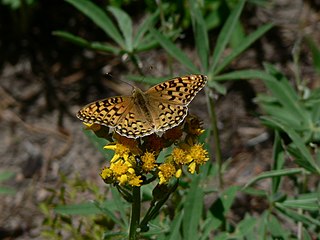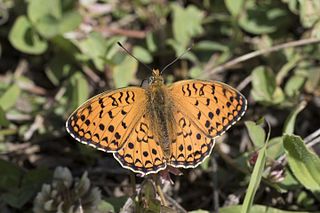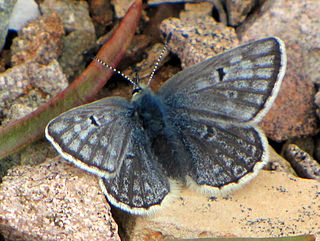
The silver-washed fritillary is a common and variable butterfly found over much of the Palearctic realm – Algeria, Europe, temperate Asia, and Japan.

Speyeria zerene, the zerene fritillary, is a butterfly found in the western portions of the United States and Canada. The species was first described by William John Swainson in 1827.

The Niobe fritillary is a species of butterfly in the family Nymphalidae.

The Queen of Spain fritillary is a butterfly of the family Nymphalidae.

The great spangled fritillary is a North American butterfly of the family Nymphalidae.

Papilio helenus, the red Helen, is a large swallowtail butterfly found in forests of southern India and parts of southeast Asia.

The Zabulon skipper is a North American butterfly first described by the French naturalists Jean Baptiste Boisduval and John Eatton Le Conte from the state of Georgia, United States.

Myrtle's silverspot is a medium-sized butterfly in the brush foot family (Nymphalidae), an endangered subspecies of the zerene fritillary. It is endemic to California, where it is known from only about four locations just north of the San Francisco Bay Area, including two at Point Reyes National Seashore. Its wingspan is approximately 2.2 inches (56 mm). The upper surfaces of the wings are golden brown with numerous black spots and lines. The undersides are brown, orange and tan with black lines and silver and black spots. Larvae are dark colored with many sharp branching spines on their backs. Myrtle's silverspot is larger and paler than the closely related Behrens' silverspot, which is now limited to the vicinity of Point Arena in Mendocino County.

Boloria chariclea, the Arctic fritillary or purplish fritillary, is a butterfly of the family Nymphalidae. It is found in the northern parts of the Palearctic and Nearctic realms.

Boloria bellona, the meadow fritillary, is a North American butterfly in the brushfoot family, Nymphalidae. The common name, meadow fritillary, is also used for a European butterfly species, Melitaea parthenoides.

Speyeria, commonly known as greater fritillaries, is a genus of butterflies in the family Nymphalidae commonly found in North America, Europe, and Asia. Some authors used to consider this taxon a subgenus of Argynnis, but it has been reestablished as a separate genus in 2017.

Euptoieta claudia, the variegated fritillary, is a North and South American butterfly in the family Nymphalidae. Even though the variegated fritillary has some very different characteristics from the Speyeria fritillaries, it is still closely related to them. Some of the differences are: variegated fritillaries have two or three broods per year vs. one per year in Speyeria; they are nomadic vs. sedentary; and they use a wide range of host plants vs. just violets. And because of their use of passionflowers as a host plant, variegated fritillaries also have taxonomic links to the heliconians. Their flight is low and swift, but even when resting or nectaring, this species is extremely difficult to approach, and, because of this, its genus name was taken from the Greek word euptoietos meaning "easily scared".

Speyeria atlantis, the Atlantis fritillary, is a butterfly of the family Nymphalidae of North America. It is from the Avalon Peninsula of Newfoundland and Labrador to northern British Columbia, across the northern United States south as far as Colorado and West Virginia. It resides as far north as James Bay. The species is listed as endangered in Connecticut.

Agriades glandon, the Arctic blue or Glandon blue, is a species of butterfly in the family Lycaenidae. It in found in Eurasia and North America.

Chlorostrymon simaethis, the silver-banded hairstreak, is a North and South American butterfly in the family Lycaenidae. It is also known as St. Christopher's hairstreak and the Key lime hairstreak.

Speyeria edwardsii, the Edwards' fritillary, is a butterfly of the family Nymphalidae of North America. It is common from Alberta west to Manitoba and south as far as northern New Mexico.

Speyeria coronis, the Coronis fritillary, is a butterfly of the family Nymphalidae of North America. It is common from Baja California to Washington and east to Colorado and western South Dakota and once reported in Alberta.

Speyeria egleis, commonly known as the Great Basin fritillary or egleis fritillary, is a butterfly of the family Nymphalidae. It is found in North America, where it has been recorded from North Dakota southwest through Oregon to California and south to Colorado. The habitat consists of mountain meadows, forest openings and exposed rocky ridges.
Speyeria carolae, or Carole's fritillary, is a butterfly in the family Nymphalidae. It was described by Cyril Franklin dos Passos and Lionel Paul Grey in 1942 and is found in North America, where it has only been recorded from the Charleston Mountains of Clark County, Nevada. The habitat consists of mountain slopes, foothills and forest openings.

Speyeria nokomis, the nokomis fritillary, is a species of fritillary in the family of butterflies known as Nymphalidae. It is found in North America.





















